Development, Uptake, and Wider Applicability of the Yo-yo Strategy in Biology Education Research: A Reappraisal
Abstract
1. Introduction
2. Context in Which Yo-yo Thinking was Developed, Justified, and Tested Originally
2.1. Learning Difficulties in Classical Genetics
- To adequately sequence the subject matter, genetics education should start on the phenomenal level of the organism that students are familiar with, i.e., their family, and should gradually descend to the cellular level. However, consistent references between the different levels of biological organization should be included;
- The relationship between meiosis and heredity should be dealt with explicitly;
- Two main cell lines, the somatic line (mitosis) and the germ line (meiosis) should be distinguished in the setting of the life cycle;
2.2. Designing and Studying a Learning and Teaching Strategy for Genetics
- Partial question (PQ) and local motive to explore and answer the PQ: creating a need for extending knowledge;
- Information and/or investigation: extending knowledge;
- Application: using the extended knowledge in a new situation;
- Reflection: reflecting on the extended knowledge.
2.3. Formal Characteristics of the Yo-yo Strategy
- Which levels of biological organization are involved in thinking upwards and downwards?
- Which conceptual understanding has been gained per level (horizontal coherence)?
- How are the concepts on the different levels interrelated (vertical coherence)?
- How are the conceptual understandings per level integrated and embedded in a pattern of explanatory reasoning about a biological phenomenon (pictorial representation, narrative storyline)?
- How did the yo-yo approach of this topic contribute to grasping the subject matter and when, why, and how could yo-yo thinking be applied in studying other biological topics? To acquire yo-yo thinking the student has to internalize this approach as a metacognition, i.e., asking himself and answering the questions a–d and thus regulating his/her own learning for coherent understanding of new biological topics. (metacognition: self-monitoring and self-controlling learning biological topics by addressing the above points a–d).
3. Analysis of Yo-yo Thinking in Selected Biology Education Research Cases
3.1. Searching, Selecting and Analysing Cases
- Which problem is being addressed in the study?
- How is yo-yo thinking interpreted in the study?
- How are students getting involved in yo-yo thinking?
- How are key concepts matched to levels of biological organization and how are the key concepts interrelated and embedded in a pattern of explanatory reasoning?
- What has been the added value of applying yo-yo thinking?
- What difficulties were encountered in implementing yo-yo thinking?
- Which recommendations for further research have been proposed so as to realise the full potential of yo-yo thinking?
3.2. Applying Yo-yo Thinking to Other Biological Subjects: The German Case
3.3. Molecular Level: The American and Dutch Case
4. Discussions
4.1. Selective Use and Further Completion
4.2. Nature of ‘Levels of Biological Organization’
4.3. Pedagogical Approach
4.4. Explanatory Context and Reasoning
4.5. Conceptual Transformation in Genetics and the Use of Mental Models
Author Contributions
Acknowledgments
Conflicts of Interest
References
- Marbach-Ad, G.; Stavy, R. Students’ cellular and molecular explanations of genetic phenomena. J. Biol. Educ. 2000, 34, 200–205. [Google Scholar] [CrossRef]
- Ferrari, M.; Chi, T.H. The nature of naïve explanations of natural selection. Int. J. Sci. Educ. 1998, 20, 1231–1256. [Google Scholar] [CrossRef]
- Ummels, M.H.; Kamp, M.J.; Kroon, H.; Boersma, K.T. Promoting conceptual coherence within context-based biology education. Sci. Educ. 2015, 99, 958–985. [Google Scholar] [CrossRef]
- Šorgo, A.; Šiling, R. Fragmented knowledge and missing connections between knowledge from different hierarchical organisational levels of reproduction among adolescents and young adults. CEPS J. 2017, 7, 69–91. [Google Scholar]
- Knippels, M.C.P.J. Coping with the Abstract and Complex Nature of Genetics in Biology Education: The Yo-Yo Learning and Teaching Strategy. Ph.D. Thesis, Utrecht University, Utrecht, The Netherlands, 19 September 2002. [Google Scholar]
- Verhoeff, R.P. Towards Systems Thinking in Cell Biology Education. Ph.D. Thesis, Utrecht University, Utrecht, The Netherlands, 5 November 2003. [Google Scholar]
- Knippels, M.-C.P.J.; Waarlo, A.J.; Boersma, K.T. Design criteria for learning and teaching genetics. J. Biol. Educ. 2005, 39, 108–112. [Google Scholar] [CrossRef]
- Verhoeff, R.P.; Knippels, M.C.P.J.; Gilissen, M.G.R.; Boersma, K.T. The Theoretical nature of systems thinking. Perspectives on systems thinking in biology education. Front. Educ. 2018, 3, 1–11. [Google Scholar] [CrossRef]
- Kattmann, U. Schüler Besser Verstehen. Alltagsvorstellungen im Biologieunterricht [A Better Understanding of Students. Everyday Notions in Biology Education]; Aulis Verlag: Hallbergmoos, Germany, 2015; pp. 206–208, 330–331. ISBN 978-3-7614-2941-9. [Google Scholar]
- Wilhelm, M. Wirksamer Biologieunterricht [Effective Biology Education]; Schneider Verlag Hohengehren: Baltsmannweiler, Germany, 2018; ISBN 978-3-8340-1900-4. [Google Scholar]
- Domis-Hoos, M.; Kapteijn, M.; Boerwinkel, D.J. Genetica in Beweging. De Moeite Waard om te Leren [Genetics in a State of Flux. Rewarding Learning]; NVON: Utrecht, The Netherlands, 2012; ISBN 978-90-8797-008-6. [Google Scholar]
- Kapteijn, M.; Kamp, M.; Hullu, E. Ecologie Leren & Onderwijzen [Learning and Teaching Ecology]; NVON: Utrecht, The Netherlands, 2018; ISBN 978-90-8797-015-4. [Google Scholar]
- Lewis, J.; Wood-Robinson, C. Genes, chromosomes, cell division and inheritance—Do students see any relationship? Int. J. Sci. Educ. 2000, 22, 177–195. [Google Scholar] [CrossRef]
- Lewis, J.; Leach, J.; Wood-Robinson, C. What’s in a cell?—Young people’s understanding of the genetic relationship between cells, within an individual. J. Biol. Educ. 2000, 34, 129–132. [Google Scholar] [CrossRef]
- Lewis, J.; Leach, J.; Wood-Robinson, C. Chromosomes: The missing link—People’s understanding of mitosis, meiosis, and fertilisation. J. Biol. Educ. 2000, 34, 189–199. [Google Scholar] [CrossRef]
- Boersma, K.T.; Knippels, M.C.P.J.; Waarlo, A.J. Developmental research: The improvement of learning and teaching of science topics. In Making a Difference: Evaluation as a Tool for Improving Science Education; Benett, J., Holman, J., Millar, R., Waddington, D., Eds.; Waxmann Verlag: New York, NY, USA; Münster, Germany, 2005; pp. 85–98. ISBN 3-8309-1508-X. [Google Scholar]
- Boersma, K.T.; Waarlo, A.J. On the theoretical input and output of ‘design research’ in biology education. In The Nature of Research in Biological Education: Old and New Perspectives on Theoretical and Methodological Issues; Hammann, M., Waarlo, A.J., Boersma, K., Eds.; CD-β Press: Utrecht, The Netherlands, 2009; pp. 463–479. ISBN 978-90-73346-66-6. [Google Scholar]
- Klaassen, C.W.J.M. A Problem-Posing Approach to Teaching the Topic of Radioactivity. Ph.D. Thesis, Utrecht University, Utrecht, The Netherlands, 6 December 1995. [Google Scholar]
- Kortland, J. A Problem Posing Approach to Teaching Decision Making about the Waste Issue. Ph.D. Thesis, Utrecht University, Utrecht, The Netherlands, 15 February 2001. [Google Scholar]
- Knippels, M.C.P.J.; Waarlo, A.J.; Boersma, K.T. Betekenisvol geneticaonderwijs: Een chromosomenpracticum. [Meaningful genetics education. A chromosome practical]. Niche 2001, 5, 14–17. [Google Scholar]
- Ben-Zvi Assaraf, O.; Dodick, J.; Tripto, J. High school students’ understanding of the human body system. Res. Sci. Educ. 2013, 43, 33–56. [Google Scholar] [CrossRef]
- Olander, C.; Per-Olof Wickman, P.O.; Tytler, R.; Ingerman, Å. Representations as mediation between purposes as junior secondary science students learn about the human body. Int. J. Sci. Educ. 2018, 40, 204–226. [Google Scholar] [CrossRef]
- Riemeier, T.; Gropengießer, H. On the roots of difficulties in learning about cell division: Process-based analysis of students’ conceptual development in teaching experiments. Int. J. Sci. Educ. 2008, 30, 923–939. [Google Scholar] [CrossRef]
- Andersson, B.; Wallin, A. On developing content-oriented theories taking biological evolution as an example. Int. J. Sci. Educ. 2006, 28, 673–695. [Google Scholar] [CrossRef]
- Tibell, L.A.E.; Harms, U. Biological principles and threshold concepts for understanding natural selection. Implications for developing visualizations as a pedagogic tool. Sci. Educ. 2017, 26, 953–973. [Google Scholar] [CrossRef]
- Rocksén, M.; Olander, C. A topical trajectory on survival: An analysis of link-making in a sequence of lessons on evolution. Res. Sci. Educ. 2017, 47, 451–472. [Google Scholar] [CrossRef]
- Jördens, J.; Asshoff, R.; Kullmann, H.; Hammann, M. Providing vertical coherence in explanations and promoting reasoning across levels of biological organization when teaching evolution. Int. J. Sci. Educ. 2016, 38, 960–992. [Google Scholar] [CrossRef]
- Westra, R. Learning and Teaching Ecosystem Behavior in Secondary Education: Systems Thinking and Modelling in Authentic Practices. Ph.D. Thesis, Utrecht University, Utrecht, The Netherlands, 18 February 2008. [Google Scholar]
- Hammann, M.; Asschof, R. Schülervorstellungen im Biologieunterricht. Ursachen für Lernschwierigkeiten [Students’ Conceptions in Biology Education. Causes of Learning Difficulties], 1st ed.; Klett Kallmeyer: Seelze, Germany, 2014; ISBN 976-3-7800-4908-7. [Google Scholar]
- Düsing, K.; Asshoff, R.; Hammann, M. Students’ conceptions of the carbon cycle: Identifying and interrelating components of the carbon cycle and tracing carbon atoms across the levels of biological organisation. J. Biol. Educ. 2018. [Google Scholar] [CrossRef]
- Jördens, J.; Asshoff, R.; Kullmann, H.; Hammann, M. Interrelating concepts from genetics and evolution: Why are cod shrinking? Am. Biol. Teach. 2018, 80, 132–138. [Google Scholar] [CrossRef]
- Verhoeff, R.P.; Waarlo, A.J.; Boersma, K.T. Systems modelling and the development coherent understanding of cell biology. Int. J. Sci. Educ. 2008, 30, 543–568. [Google Scholar] [CrossRef]
- Wilensky, U.; Resnick, M. Thinking in levels: A dynamic systems approach to making sense of the world. J. Sci. Educ. Technol. 1999, 8, 3–19. [Google Scholar] [CrossRef]
- Brown, M.H.; Schwartz, R.S. Connecting photosynthesis and cellular respiration: Preservice teachers’ conceptions. J. Res. Sci. Teach. 2009, 46, 791–812. [Google Scholar] [CrossRef]
- Duncan, R.G.; Tseng, K.A. Designing project-based instruction to foster generative and mechanistic understandings in genetics. Sci. Educ. 2011, 95, 21–56. [Google Scholar] [CrossRef]
- Van Mil, M.H.W.; Boerwinkel, D.J.; Waarlo, A.J. Modelling molecular mechanisms: A framework of scientific reasoning to construct molecular-level explanations for cellular behaviour. Sci. Educ. 2013, 22, 93–118. [Google Scholar] [CrossRef]
- Van Mil, M.H.W.; Postma, P.A.; Boerwinkel, D.J.; Klaassen, K.; Waarlo, A.J. Molecular mechanistic reasoning: Toward bridging the gap between the molecular and cellular levels in life science education. Sci. Educ. 2016, 100, 517–585. [Google Scholar] [CrossRef]
- Duncan, R.G.; Reiser, B.J. Reasoning across ontologically distinct levels: Students’ understandings of molecular genetics. J. Res. Sci. Teach. 2007, 44, 938–959. [Google Scholar] [CrossRef]
- Duncan, R.G.; Choi, J.; Castro-Faix, M.; Cavera, V.L. A study of two instructional sequences informed by alternative learning progressions in genetics. Sci. Educ. 2017, 26, 1115–1141. [Google Scholar] [CrossRef]
- Craver, C.F. Role functions, mechanisms, and hierarchy. Philos. Sci. 2001, 68, 53–74. [Google Scholar] [CrossRef]
- Craver, C.F.; Bechtel, W. Top-down causation without top-down causes. Biol. Philos. 2007, 22, 547–563. [Google Scholar] [CrossRef]
- Boerwinkel, D.J.; Waarlo, A.J.; Boersma, K. A designer’s view: The perspective of form and function. J. Biol. Educ. 2009, 44, 12–18. [Google Scholar] [CrossRef]
- Grotzer, T.A. Learning Causality in a Complex World: Understandings of Consequence; Rowman & Littlefield Education: Plymouth, UK, 2012; ISBN 978-1-61048-864-8. [Google Scholar]
- Eronen, M.I.; Brooks, D.S. Levels of Organization in Biology. In The Stanford Encyclopedia of Philosophy. Available online: https://plato.stanford.edu/archives/spr2018/entries/levels-org-biology/ (accessed on 22 August 2018).
- Lijnse, P.L.; Klaassen, C.W.J.M. Didactical structures as an outcome of research on teaching-learning sequences. Int. J. Sci. Educ. 2004, 26, 537–554. [Google Scholar] [CrossRef]
- Freidenreich, H.B.; Duncan, R.G.; Shea, N. Exploring middle school students’ understanding of three conceptual models in genetics. Int. J. Sci. Educ. 2011, 33, 2323–2349. [Google Scholar] [CrossRef]
- Gericke, N.; El-Hani, C.N. Genetics. In Teaching Biology in Schools. Global Research, Issues, and Trends, 1st ed.; Kampourakis, K., Reiss, M.J., Eds.; Routledge: New York, NY, USA; London, UK, 2018; pp. 35–47. ISBN 978-1-138-08798-9. [Google Scholar]
- Duncan, R.G.; Boerwinkel, D.J. Molecular biology. In Teaching Biology in Schools: Global Research, Issues, and Trends, 1st ed.; Kampourakis, K., Reiss, M.J., Eds.; Routledge: New York, NY, USA; London, UK, 2018; pp. 111–123. ISBN 978-1-138-08798-9. [Google Scholar]
- Duncan, R.G.; Rogat, A.; Yarden, A. A learning progression for deepening students’ understanding of modern genetics across the 5th–12th grades. J. Res. Sci. Teach. 2009, 46, 644–674. [Google Scholar] [CrossRef]
- Rheinberger, H.-J.; Müller-Wille, S. The Gene: From Genetics to Postgenomics, 1st ed.; The University of Chicago Press: Chicago, IL, USA; London, UK, 2017; ISBN 987-0-226-51000-2. [Google Scholar]
- Boerwinkel, D.J.; Yarden, A.; Waarlo, A.J. Reaching a consensus on the definition of genetic literacy that is required from a twenty-first-century citizen. Sci. Educ. 2017, 26, 1087–1114. [Google Scholar] [CrossRef]
- Hammann, M. Organisationsebenen biologischer Systeme unterscheiden und vernetzen: Empirische Befunde und Empfehlungen für die Praxis [Distinguishing and interrelating levels of biological organization: Empirical findings and practical implications]. In Biologiedidaktische Forschung: Perspektiven für die Praxis [Biology Education Research: Practice Oriented Perspectives]; Groß, J., Hammann, M., Schmiemann, P., Zabel, J., Eds.; Springer: Heidelberg, Germany; New York, NY, USA, 2018; in press. [Google Scholar]
- Olander, C.; Holmqvist-Olander, M. Professional development through the use of learning study: Contributions to pedagogical content knowledge in biology. Procedia Soc. Behav. Sci. 2013, 89, 205–212. [Google Scholar] [CrossRef]
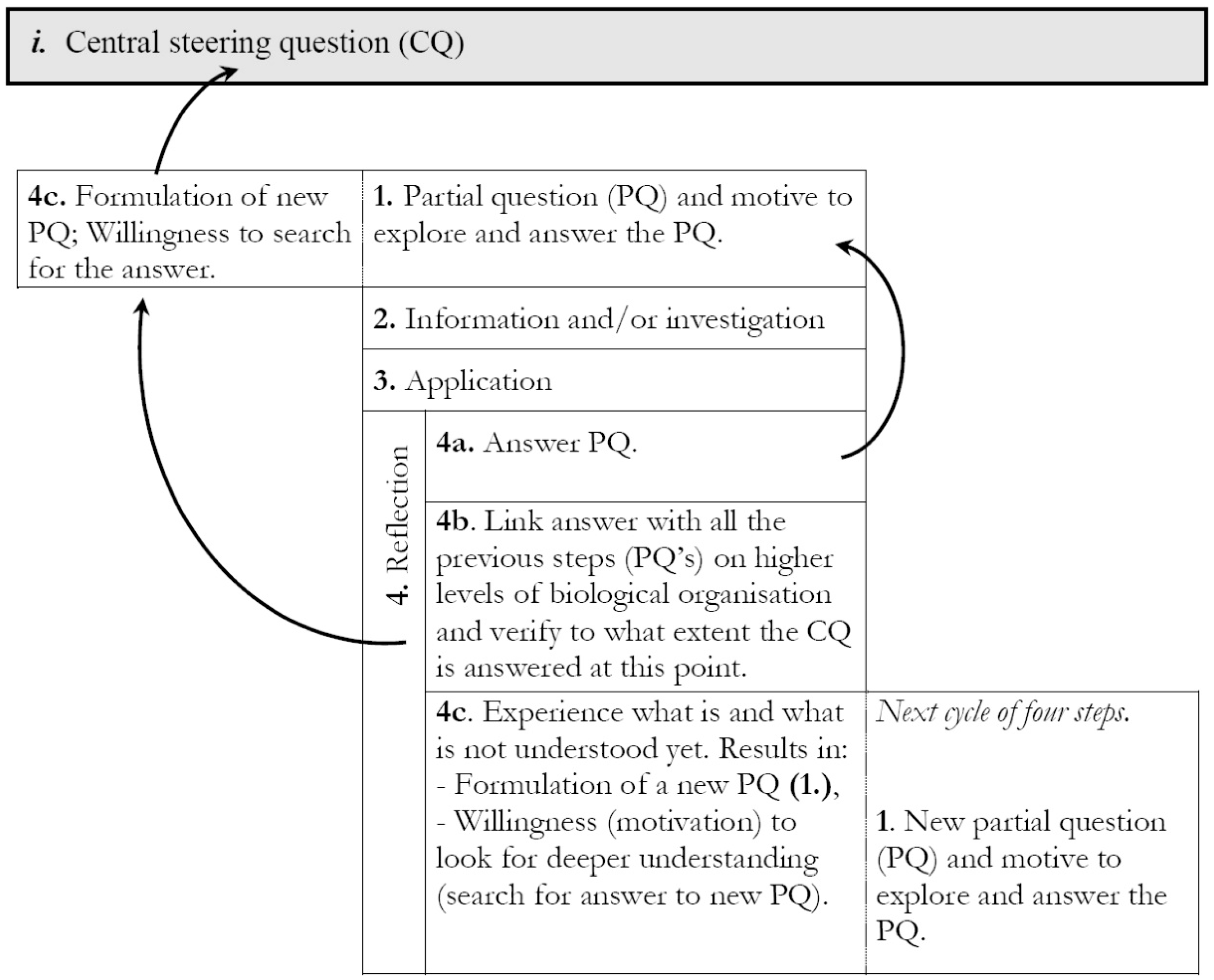
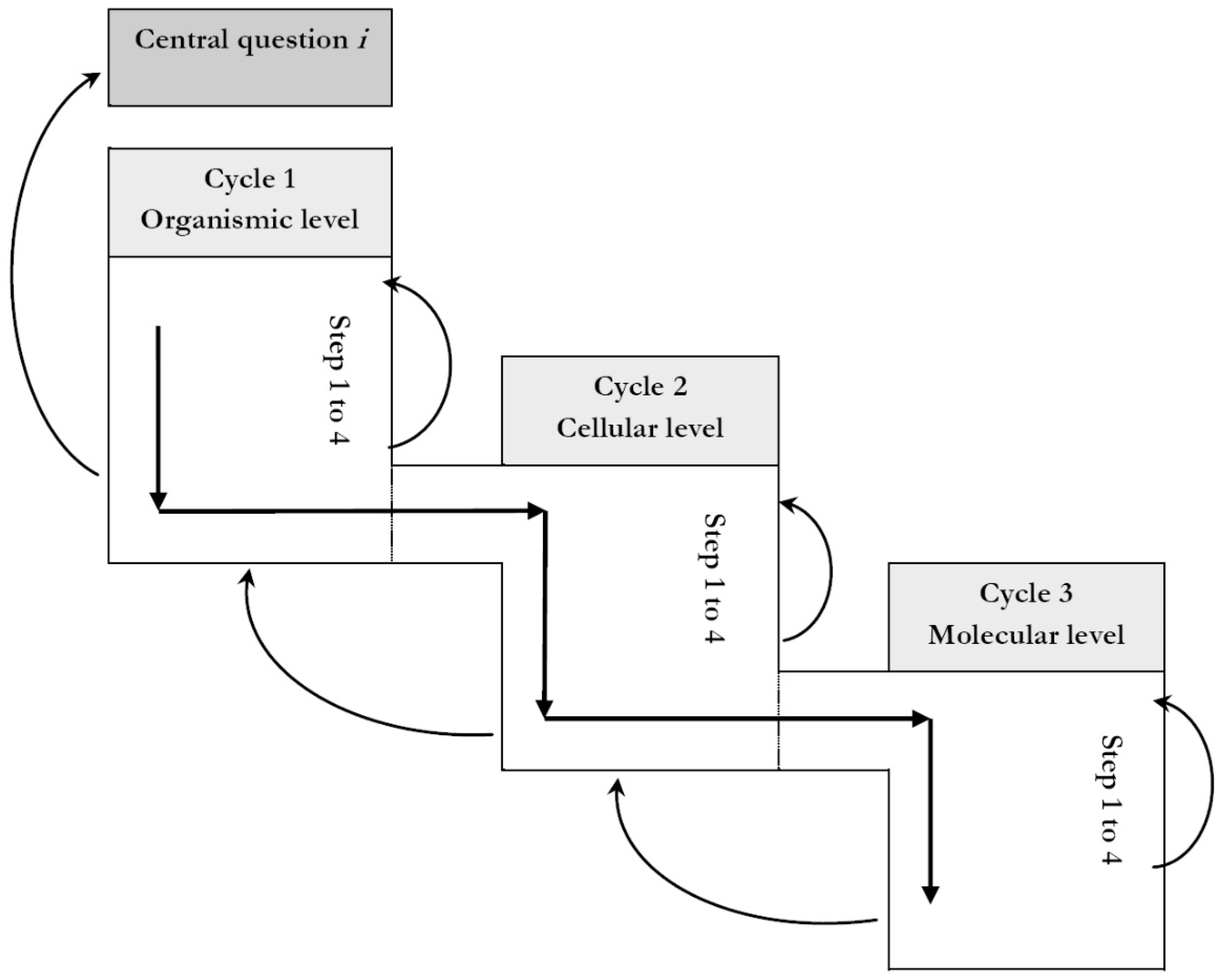
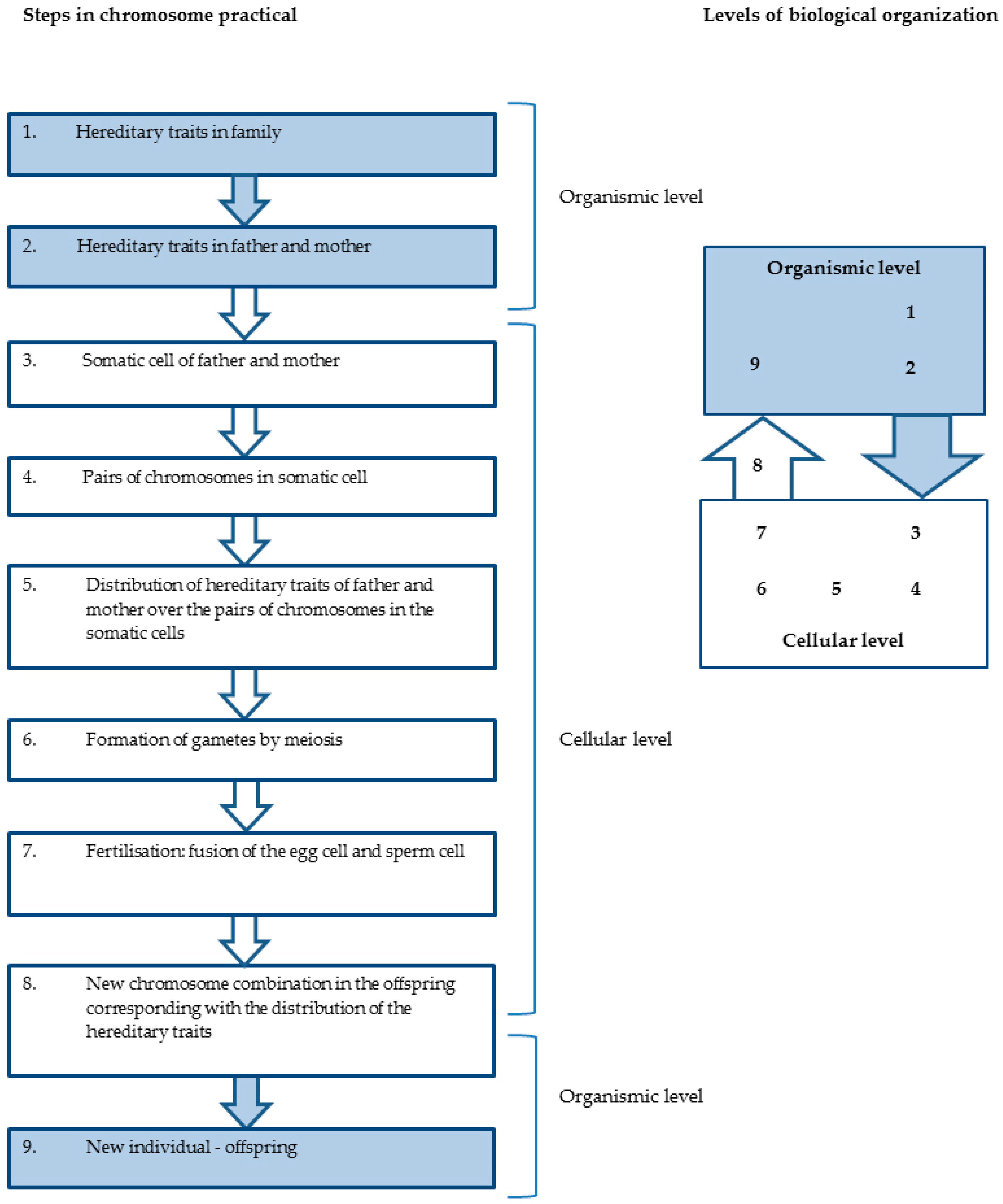
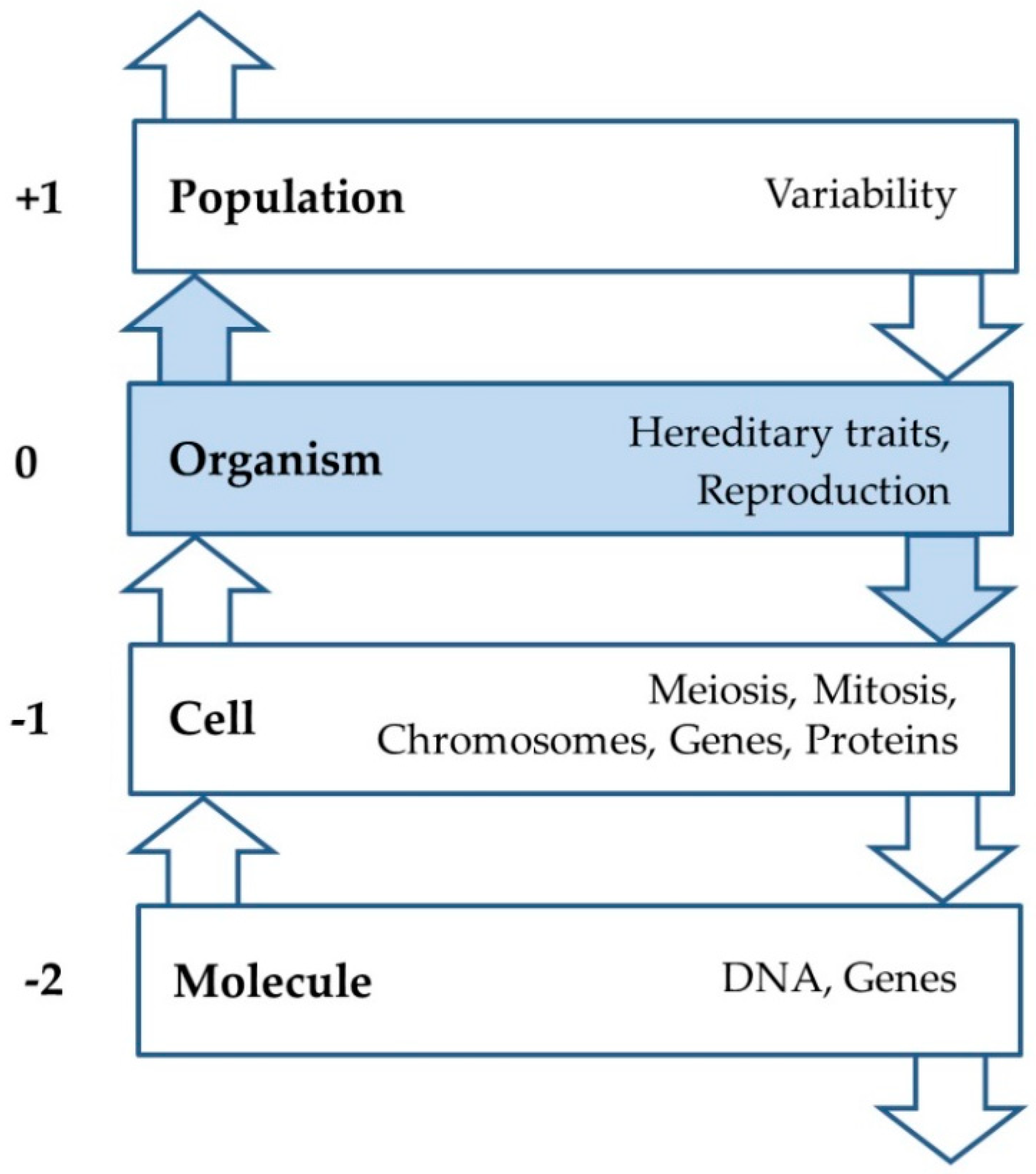
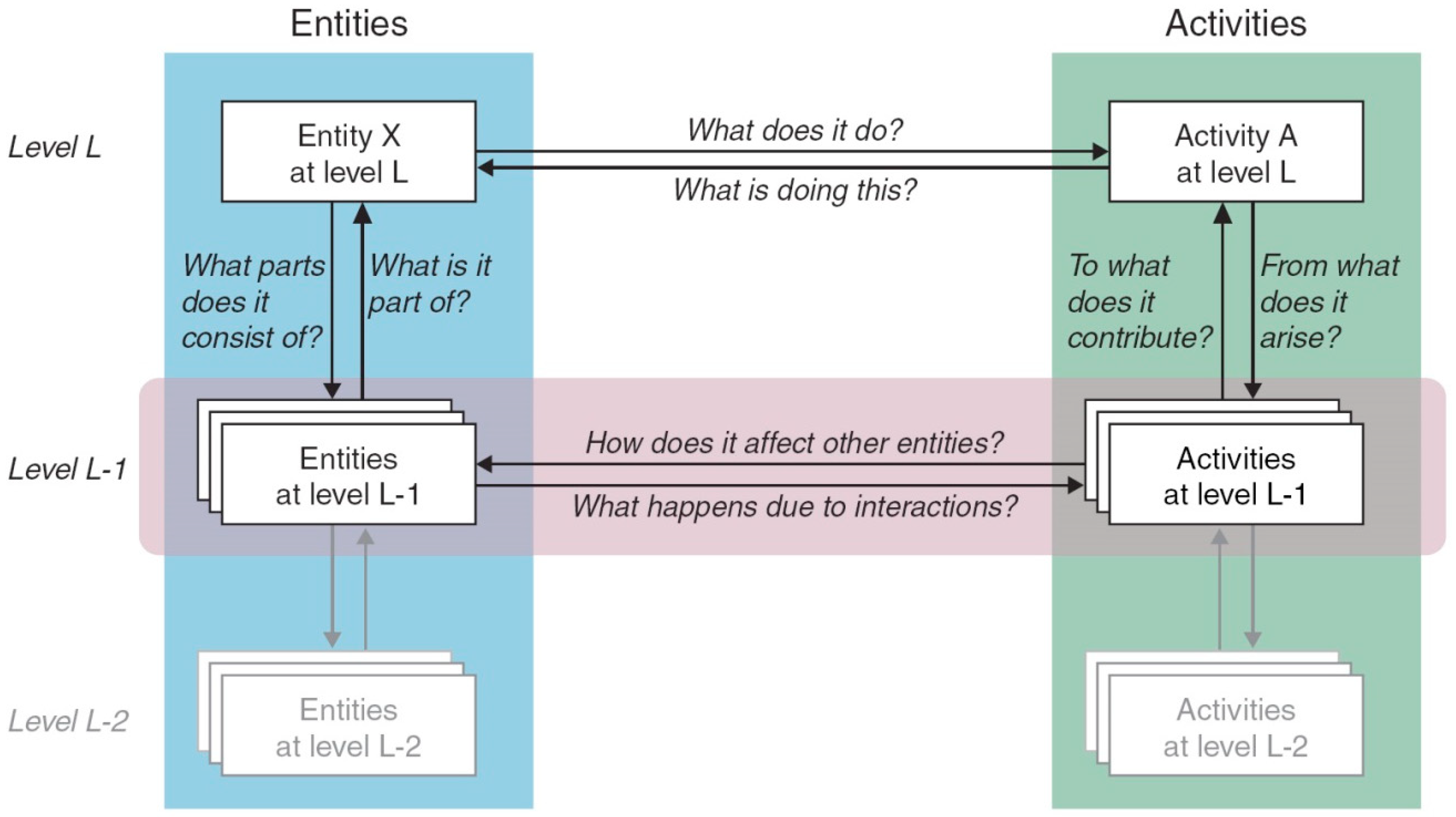
| Questions | Answers | |
|---|---|---|
| Organismic level | Everybody is familiar with hereditary phenomena in families. | |
| What makes you look like your parents, but not being identical to them? (central question) | ||
| Sex life links parents and offspring (sexual reproduction: SR), but this does not apply to organisms that produce identical progeny (asexual reproduction: AR). | ||
| What distinguishes sexual from asexual reproduction? | ||
| In AR there is one parent and in SR a fusion of egg and sperm cell, originating from mother and father respectively, takes place. | ||
| What structures are being passed on in AR and SR? | ||
| Cellular level | In AR as well as in SR dividing cells, which contain nuclei with chromosomes, are the vehicle of genetic instructions. | |
| What happens to chromosomes during cell division? | ||
| In AR the chromosomes are copied and divided equally among the daughter cells (mitosis). So the parent cell divides to form two identical cells. In SR a cell divides by two divisions into four germ cells, each containing half the original number of chromosomes (meiosis). | ||
| How does mitosis fit in the life cycle of multi-cellular organisms? | ||
| AR is analogous to the somatic cell line: from the zygote mitosis leads to growth and development. Any mutation in this cell line will not affect the next generation, contrary to a mutation in the germ cell line. | ||
| What makes chromosomes determine the different hereditary traits in an organism? | ||
| Chromosomes contain genes (and alleles) which instruct the cell to produce all kind of proteins. The latter have different structural and functional roles, which are expressed in hereditary traits. | ||
| How do genetic traits on the organismic level relate to chromosome structure and behaviour on the cellular level? | ||
| Fusion of two gametes forms a zygote with a random recombination of homologue chromosomes (and their genes) from both parents. | ||
| How unique is an individual’s genetic make-up? | ||
| The forming and fusion of gametes in SR are random processes, which add to a very large genetic diversity, i.e., unique individuals. | ||
| Molecular level | ||
| How do genes work? | The genes in the chromosomes are made of DNA, which stores and faithfully transmits information. The information-carrying capacity of DNA comes from the 4 bases; they are ‘read’ as if they were letters, making up words of three bases long. These words give the information needed for building proteins, and for organising the activity of the cell. | |
| Meta-reflection | ||
| Which levels of biological organization have been transected in succession and what is the added value of thinking backward-and-forward between these levels? | ||
| In descending from organism to cells and molecules and ascending vice versa biological structures, processes and concepts can be interrelated enabling us to build up a coherent conceptual understanding of heredity. This backward-and-forward thinking is helpful in grasping hereditary phenomena. | ||
| Levels of Biological Organization | Key Concepts | |
|---|---|---|
 | Population | Variability, gene pool, allele frequencies |
 | Organism | Hereditary traits, phenotype (size of the cod) |
 | Cell | -- |
 | Molecule | Alleles, genes |
© 2018 by the authors. Licensee MDPI, Basel, Switzerland. This article is an open access article distributed under the terms and conditions of the Creative Commons Attribution (CC BY) license (http://creativecommons.org/licenses/by/4.0/).
Share and Cite
Knippels, M.-C.P.J.; Waarlo, A.J. Development, Uptake, and Wider Applicability of the Yo-yo Strategy in Biology Education Research: A Reappraisal. Educ. Sci. 2018, 8, 129. https://doi.org/10.3390/educsci8030129
Knippels M-CPJ, Waarlo AJ. Development, Uptake, and Wider Applicability of the Yo-yo Strategy in Biology Education Research: A Reappraisal. Education Sciences. 2018; 8(3):129. https://doi.org/10.3390/educsci8030129
Chicago/Turabian StyleKnippels, Marie-Christine P.J., and Arend Jan Waarlo. 2018. "Development, Uptake, and Wider Applicability of the Yo-yo Strategy in Biology Education Research: A Reappraisal" Education Sciences 8, no. 3: 129. https://doi.org/10.3390/educsci8030129
APA StyleKnippels, M.-C. P. J., & Waarlo, A. J. (2018). Development, Uptake, and Wider Applicability of the Yo-yo Strategy in Biology Education Research: A Reappraisal. Education Sciences, 8(3), 129. https://doi.org/10.3390/educsci8030129




